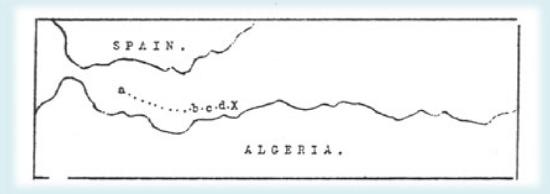The attack on "UNTRUE" (KMS-31), 11 November 1943
|
 |

|
Key to map:
|
The dotted line is the track of the convoy.
X marks the location of the attack.
The other letters indicate times/dates and places that reconnaissance aircraft of 1.(F)/33 called in reports of the convoy, as follows:
|
|
a = 1635/10
d = 1346/11
|
b = 0607/11
X = Dusk/11
|
c = 1139/11
|
|
Times are GMT (local time is one hour later)
|
On 12 November III./KG 26 sent out a lone aircraft carrying the FuG 200 Hohentwiel search radar (but without torpedoes) to find and to maintain contact with KMS-31:
To find the convoy east-west search courses were flown in zigzags, full circles and 180º courses and left and right turns along the coast, 25–40 km offshore at 200 m altitude. 180º courses gave good navigational indications of position and precise locations. In the bad visibility the convoy would not have been found without the set.
A Ju 88 picked up the eastbound convoy at 17.35 local time, reporting 48 ships steaming at 8 knots, 45 miles west of Alborán Island. A Ju 88 of 1.(F)/33 made contact at 07.07 hours next morning, reporting on the convoy’s composition and the weather in the area. Two more Ju 88s shadowed throughout the day, the second of these being instructed at 13.20 hours to send all future reports on bomber frequencies, an early sign that an attacking force was on its way. At 16.46 hours, the convoy was reported to consist of 15 merchant vessels and four destroyer escorts, course 80 degrees and speed 6 knots.
|
Note: www.convoyweb.org.uk has a list of the merchant vessels in the convoy.
|
 |
Daylight air defence of "UNTRUE" was provided by pairs of P-39s at 1,000 ft, 4,000 ft and 6–8,000 ft. patrolling about three miles outside the convoy while a single Walrus provided close anti-submarine cover. At night there were six Beaufighters, four of them freelancing 10 miles north of the convoy at 2,000 ft. As the attack developed, there were 15 friendly aircraft “distributed at various heights and in various positions up to 15 miles North of the convoy.”
This number of defending machines showing IFF and at the same range as the attacking force saturated the radar plot which was further confused by echoes from some of the larger vessels. All ships deployed smoke floats at 17.55 hours and within half an hour the screen effectively concealed the convoy's composition, course and speed.
Attacks commenced at 18.20 hours, north east of Oran and the ships’ AA opened fire. The first wave consisted of 10–12 Do 217s at 3,000 feet. The first of the Dorniers ran in from dead ahead, into the setting sun and launched its Hs 293. Explosions were observed 500 yards ahead of the leading escort but no ships were hit. The next nine Do 217s approached from the west on the starboard quarters by Ketten.
At 18.40 hours, 12–15 He 111s approached from landward in a single formation at 300 feet. Flares were dropped and the Heinkels spread out over the convoy prior to dropping their torpedoes in two attacks. One He 111 banking steeply to port after releasing its "eel" was destroyed by AA fire from two ships.
Initial reports were that five ships had been hit, all by torpedoes:
|
• Indian Prince
|
torpedoed, sank under tow five hours later.
|
• Birchbank
|
hit and blew up.
|
• Carlier
|
(Belgian oiler) missing, presumed to have blown up.
|
• Nivose
|
(French oiler) hit and blew up. Another account indicates that she was torpedoed and sank by the stern at 19.10 but that all hands were saved.
|
• Josiah Parker
|
hit but continued in the convoy.
|
The escorts reported that the SS Takliwa had also been damaged but was able to continue. The Flower Class corvette, HMS Oxlip (K123) reportedly had her steering gear damaged but this was repaired and she continued in the convoy.
A Beaufighter intercepted two Do 217s on their return flight, reporting two cannon strikes on the starboard wing root of the first. It attacked the second bomber with its 0.303 machine guns before losing it in cloud.
The Dorniers were from II./KG 100 and the Heinkels from III./KG 26. Although the MAAF and Admiralty reports compiled in the immediate aftermath (and on which the above account is largely based) do not mention them, the Ju 88s of I./KG 26 also took part.
The RAF's signals intelligence unit in the Mediterranean, No. 329 Wing, summed up the attack as follows (times have been amended from GMT to local time):
The attack by He 111 and Ju 88 torpedo bombers of I. and III./KG 26 and Do 217s of II./KG 100 developed shortly before 1900. Two of the II./KG 100 aircraft turned back early and there were at least two casualtiies. At 1905 one aircraft which was subsequently called unsuccessfully until 1946 reported that its engine was damaged and that it was 50 miles north east of CAPE TENEZ, while a rubber dinghy, with crew, was reported at 1902 in the neighbourhood of the convoy.
|
Luftflotte 3's recorded aircraft losses in action on this date were:
|
I./KG 26
|
6 He 111 H-11 lost in action off Cape Ivi.
|
|
|
He 111 H-11 damaged 25% in a take-off accident.
He 111 H-11 damaged 15% by Flak.
|
III./KG 26
|
Ju 88 A-4 ditched off Barcelona, fuel shortage, crew in Spain.
|
|
|
2 Ju 88 A-4 lost in action off Cape Ivi.
|
continued on next page …

|

